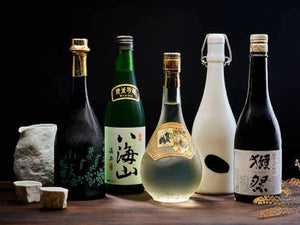
Sake Rice - 36 Types of Sakamai
Sakamai, or 酒米 (さかまい), refers to the rice varieties specifically cultivated for sake brewing in Japan. These varieties are distinct from table rice (shokumai) due to their unique characteristics, such as larger grain size, higher starch content, and lower protein content, which are ideal for sake production. This allows for more efficient conversion of starches into sugars during the fermentation process, which creates sake.

Well-known sakamai varieties include:
1. Yamada Nishiki: Often called the "king of sake rice," it is highly prized for its consistency and high quality, especially for premium sake.
2. Gohyakumangoku: Known for producing light and clean sake, it is popular in Niigata Prefecture.
3. Omachi: One of the oldest sake rice varieties, known for its rich and earthy flavors.
4. Miyama Nishiki: Grown in colder regions like Nagano, it produces sake with a robust and rich taste.
5. Hattannishiki: Popular in Hiroshima, it is known for its balanced flavor profile.
6. Dewasansan: Grown in Yamagata, it is known for producing sake with fruity and floral notes.
7. Koshi Tanrei: A hybrid of Yamada Nishiki and Gohyakumangoku, grown in Niigata, known for its smooth and elegant sake.
8. Shinriki: An ancient variety that has seen a revival, known for its complex flavors.
9. Tamazakae/Tamasakae: Known for producing sake with a full-bodied and rich profile.
Other varieties:
10. Aiyama: Known for its large grains and good water absorption. It is used to produce rich and full-bodied sake with a smooth texture.
11. Aizan: This variety produces sake with a good balance of sweetness and acidity, contributing to a well-rounded flavor profile.
12. Akamai: Used for producing sake with distinctive aromas and a clean, crisp finish.
13. Awa Yamadanishiki: A variant of Yamadanishiki grown in the Tokushima Prefecture, known for its high quality and similar characteristics to its parent variety.
14. Fuchu Homare: Produces sake with a rich flavor and good umami, often used in junmai sake.
15. Ginpu: Grown in Hokkaido, this rice produces sake with a clean and crisp flavor, often with floral and fruity notes.
16. Ginfubuki: Known for its large grains and ability to produce sake with a light and smooth taste.
17. Hidahomare: Cultivated in Gifu, it produces sake with a good balance of sweetness and acidity, often with a slightly fruity aroma.
18. Hinohikari: Known for its robustness, it produces sake with a rich and full-bodied flavor.
19. Hiyokomochi: Produces sake with a smooth texture and balanced flavor, often with a slightly sweet finish.
20. Hokuriku 12: A newer variety known for its high quality and ability to produce sake with a clean and crisp taste.
21. Hokuriku 22: Similar to Hokuriku 12, it produces sake with a clean and smooth flavor profile.
22. Kame no O: An ancient variety revived in recent years, known for its earthy and complex flavors.
23. Kinmon Nishiki: Produces sake with a good balance of richness and smoothness, often with a slight sweetness.
24. Kitanishiki: Known for its resilience, it produces sake with a light and refreshing flavor.
25. Koshihikari: Typically used for table rice, but when used for sake, it produces a well-balanced and smooth flavor.
26. Koshi no Shizuku: A hybrid of Yamada Nishiki and Gohyakumangoku, known for its smooth and elegant sake.
27. Oyama Nishiki: Produces sake with a good balance of sweetness and acidity, often with a smooth finish.
28. Saka Nishiki: Known for producing sake with a clean and crisp flavor, often with a light and refreshing taste.
29. Sasamizu: Produces sake with a smooth texture and balanced flavor, often with subtle fruity notes.
30. Senbon Nishiki: Known for its large grains and ability to produce sake with a rich and full-bodied flavor.
31. Toyonishiki: Known for producing sake with a smooth and well-balanced flavor, often with a light and clean finish.
32. Tsuyuhakaze: Produces sake with a smooth texture and balanced flavor, often with subtle floral notes.
33. Yamadaho: A parent variety of Yamada Nishiki, known for its rich and full-bodied flavors.
34. Yumenishiki: Produces sake with a smooth and well-balanced flavor, often with a slightly fruity finish.
35. Yumeginga: Known for its resilience and ability to produce sake with a light and refreshing flavor.
36. Yumeshizuku: Produces sake with a smooth texture and balanced flavor, often with subtle fruity and floral notes.

